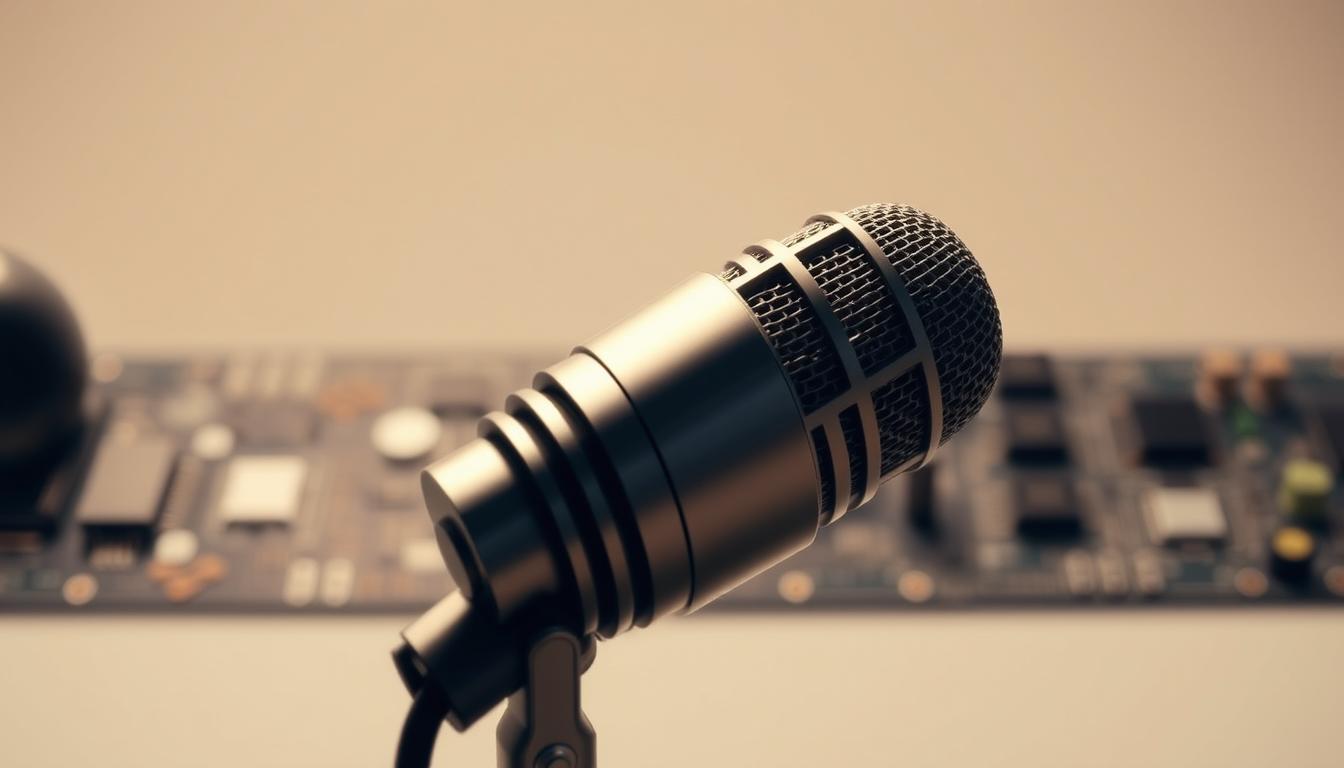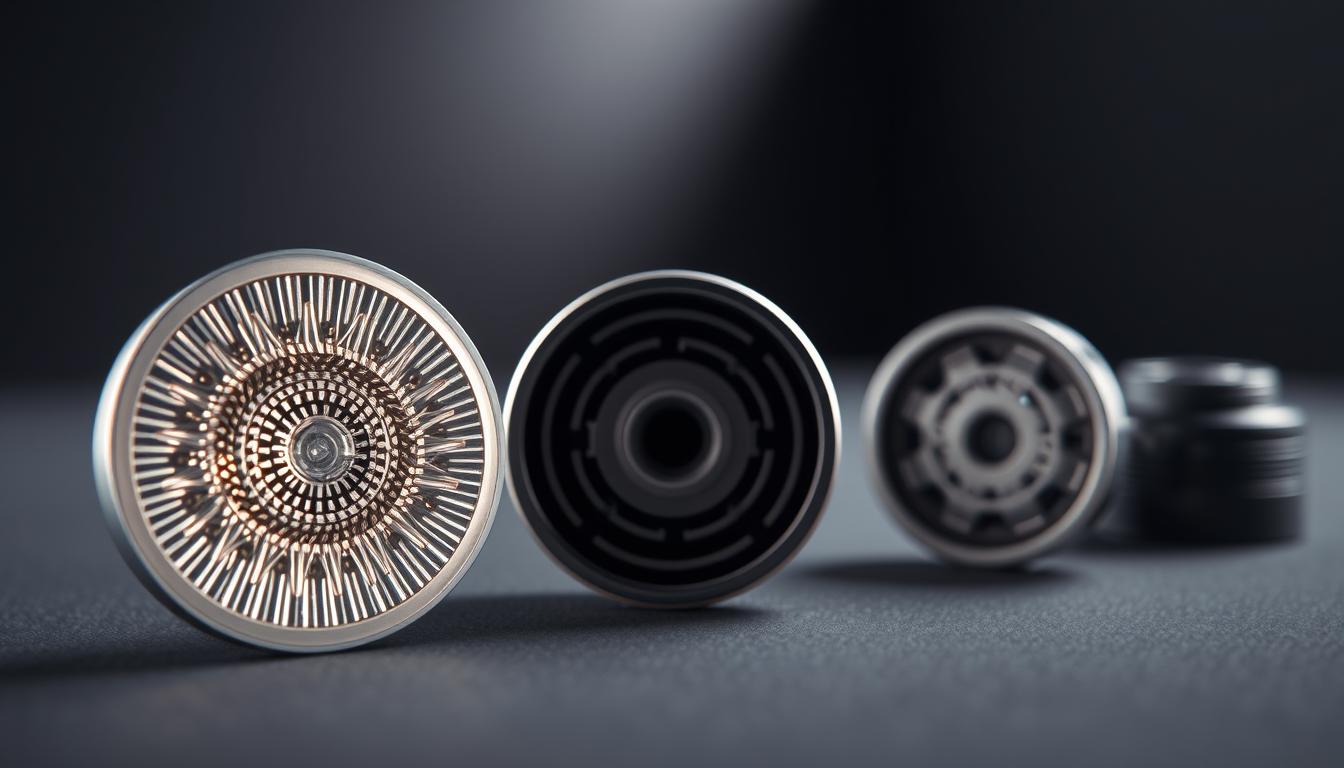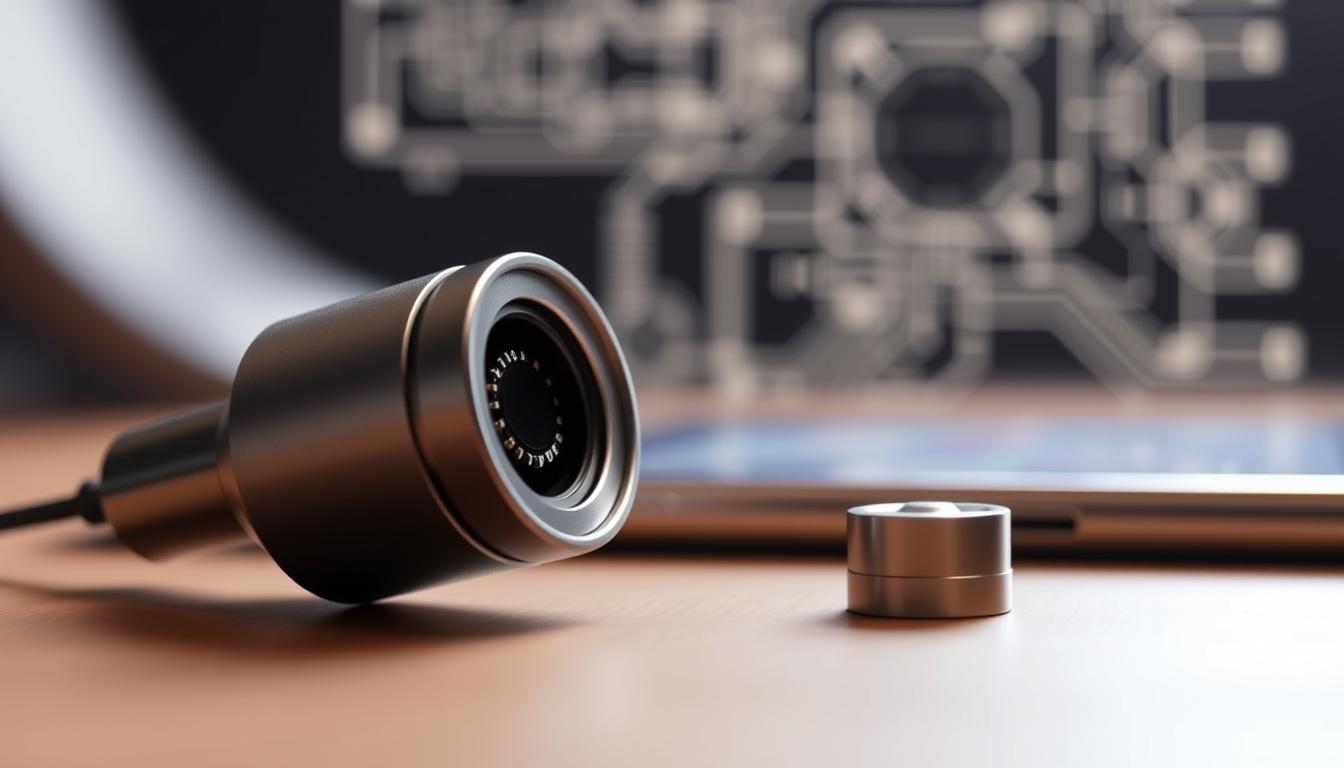Soundskrit MEMS microphone - Mobile Audio Innovation
Soundskrit MEMS technology is revolutionizing mobile audio. These miniature acoustic sensors deliver exceptional sound quality in portable devices. Their unique directionality outperforms traditional solutions.
This innovation transforms audio capture on smartphones, tablets, and laptops. MEMS technology integrates the functionality of a microphone array into a single chip. This reduces power consumption and simplifies integration for manufacturers.
Soundskrit directional microphones capture voice with remarkable clarity. They rival high-end conferencing equipment, using only two microphones. This technical feat meets consumer expectations for impeccable audio quality.
Key points to remember
- Superior sound quality in a compact size
- Significant reduction in ambient noise
- Optimized energy consumption
- Easy integration for manufacturers
- Performance comparable to professional equipment
- Improved voice recognition
Introduction to Directional MEMS Technology
Directional MEMS technology is transforming acoustic transducers . Soundskrit audio chips , unveiled at CES 2023, represent a major innovation for digital microphones in mobile devices.
The revolution of directional audio capture
Soundskrit MEMS microphones capture sound on a precise axis, eliminating unwanted noise. This innovative approach delivers superior sound quality, even in noisy environments.
The "XY" configuration uses two microphones at 90° angles to create an immersive stereo recording. This method produces detailed and realistic sound.
The advantages of MEMS microphones over traditional solutions
Soundskrit MEMS microphones outperform conventional solutions. With just two microphones, they rival specialized conferencing equipment.
Their XY privacy mode eliminates background noise using artificial intelligence. Additionally, they can distinguish between two voices, improving multi-speaker transcription.
Soundskrit innovation in the audio field
Soundskrit offers the industry's first high-performance directional MEMS microphones. Available in both analog and digital versions, these chips offer unparalleled flexibility.
SimplyDSP software ensures optimal sound quality with minimal distortion. These microphones are easily integrated into various products such as webcams, headsets, and security cameras.
Soundskrit MEMS Microphone: Technical Specifications
Soundskrit silicon microphones are disrupting the market with their 0600 and 0400 series. These high-performance directional MEMS microphones incorporate major innovations for optimal audio capture. Their manufacturing pushes current technological boundaries.
The SKR0600, the crown jewel of this range, delivers remarkable performance. It outperforms traditional models in several crucial aspects. Its impressive versatility allows it to adapt to various acoustic configurations.
- SNR (signal-to-noise ratio) of 67.5 dBA
- Directivity index of 4.8 dB
- Maximum sound pressure level of 134 dB SPL
- Power consumption of only 115 µA
- Ultra-compact dimensions: 3.50 x 2.65 x 1.31 mm³
These specifications provide an SNR gain greater than 14 dB compared to conventional omnidirectional microphones. The SKR0600 can be configured in dipole, hypercardioid, supercardioid or cardioid patterns depending on specific needs.

The innovative design of these MEMS allows for optimal operation despite reduced spacing between the acoustic ports. This feature makes them ideal for compact devices. Their low power consumption and lightweight audio processing broaden their application range.
Soundskrit microphones deliver exceptional audio clarity with up to 70 dB of noise rejection. Their analog and digital outputs facilitate integration into a variety of modern audio equipment. These advantages make them ideal solutions for many technological applications.
Applications and Sectors of Use
Soundskrit MEMS microphones transform audio with their advanced directional technology. These innovative devices are suitable for numerous applications, bringing sophisticated audio solutions to various industries.
Laptop and Tablet Solutions
Soundskrit MEMS microphones integrate seamlessly with laptops and tablets. They enable productive conferences thanks to their high-quality directional sound capture. This technology ensures exceptional audio clarity, even in noisy environments.
Integration into headsets and headphones
The headphones and earphones leverage Soundskrit technology. These compact and energy-efficient MEMS microphones significantly improve audio quality. They also preserve device battery life, providing an optimal user experience.
Applications for augmented and virtual reality
In augmented and virtual reality, Soundskrit MEMS microphones are essential. They ensure accurate and immersive audio capture, crucial for realistic and captivating AR/VR experiences.
Home security systems
Home security systems also benefit from this advanced technology. Soundskrit MEMS microphones provide cutting-edge audio monitoring. They detect and isolate relevant sounds with remarkable accuracy.
ApplicationBenefits of Soundskrit MEMS MicrophonesLaptopsAudio Clarity for Video ConferencingHeadsets and EarphonesEnhanced Sound Quality, Low Power ConsumptionAR/VRImmersive and Accurate Audio CaptureHome SecurityReliable and Targeted Sound Detection
The versatility of Soundskrit MEMS microphones makes them an ideal solution for many industries. They outperform traditional CMOS microphones in terms of performance. Their easy integration paves the way for exciting audio innovations in various technological fields.
Performance and Audio Quality
Soundskrit acoustic sensors are transforming mobile audio. MEMS technology delivers exceptional sound quality and optimal power efficiency. These acoustic transducers are redefining industry standards.
Ambient noise reduction
Soundskrit directional microphones outperform traditional noise reduction solutions. They eliminate more noise than omnidirectional arrays, even with advanced AI. Two Soundskrit microphones match the performance of dedicated conferencing equipment.

Clarity of voice capture
Soundskrit's MEMS technology ensures unparalleled voice clarity. Their microphones maintain directionality from 20 Hz to 20 kHz. This ensures precise isolation of desired sounds across the entire audio range.
With over 10 dB of additional signal-to-noise ratio, voice quality remains exceptional. This superior performance is maintained even in compact sizes.
Energy efficiency
Power efficiency is paramount in the design of Soundskrit acoustic transducers . Omnidirectional microphones require large, power-hungry arrays. In contrast, Soundskrit directional microphones deliver superior performance with lightweight processing.
Feature Soundskrit Microphones Traditional Microphones Signal-to-Noise Ratio +10 dB vs. Leaders 17 dB Loss at 10 mm Spacing Directionality 20 Hz - 20 kHz Limited Size Smallest on the Market Large Arrays Required
Integration and Compatibility
Soundskrit digital microphones offer simplified integration and broad compatibility. The SKM1600 series, with its dipole and omnidirectional microphone, integrates easily into consumer electronics. This flexibility allows manufacturers to optimize their products without additional complexity.
Soundskrit audio chips , such as the SKR0410, offer a PDM output for direct connection to existing systems. This feature eliminates the need for external audio codecs, reducing costs and complexity. Compatibility extends to a variety of devices, from webcams to VR headsets.
The SKM2600 silicon microphones offer a low-power, zero-latency alternative to traditional solutions. Available in dipole or hypercardioid configurations, they are suitable for a variety of applications. Their ease of integration reduces development time while improving audio performance.
FeatureSKM1600SKM2600Microphone TypeDipole + OmnidirectionalDirectional (Dipole or Hypercardioid)OutputAnalog (SKM1600) / PDM (SKM1610)AnalogProtectionIP57 with integrated acoustic meshNot specifiedMountingPre-applied adhesive layerNot specifiedApplicationsSpeakerphones, webcams, video barsHeadsets, voice badges
Benefits for Equipment Manufacturers
Soundskrit MEMS microphones are transforming microphone design for manufacturers. This innovative technology delivers significant benefits in cost, implementation, and scalability.
Reduction of production costs
Soundskrit's directional technology reduces the number of microphones required in devices. The iPhone uses four microphones, while the Amazon Echo has seven. Soundskrit's MEMS microphones could reduce these numbers, lowering production costs.

Simplicity of implementation
Soundskrit's SKM1600 and SKM2600 modules make integration easy for manufacturers. The SKM1600 combines dipole and omnidirectional microphones, offering a variety of pickup patterns to eliminate unwanted noise.
The SKM2600 features a sleek design with a single directional microphone. It is available in dipole or hypercardioid versions.
Design flexibility
Soundskrit technology offers significant manufacturing flexibility. SKM modules reduce prototyping iterations for developing new products. This technology is already being used in various fields.
The market is expected to reach USD 3.26 billion by 2029, growing at a CAGR of 6.32% annually. Soundskrit CMOS microphones represent a major opportunity for innovative equipment manufacturers.
Solutions for Professional Audio
The Soundskrit MEMS Microphone is revolutionizing professional audio. This MEMS technology delivers exceptional performance in a compact form factor. It's ideal for conferencing systems and broadcast applications.
Conference systems
Soundskrit acoustic sensors transform conferences with their directional technology. They enable clear voice capture several meters away from the microphone. Participants can move freely without losing audio quality.
This innovation meets the needs of modern and flexible workspaces. It offers a solution adapted to the new requirements of professional environments.
Broadcast applications
In broadcasting, Soundskrit MEMS technology excels with studio quality in a compact form factor. Its ability to reduce ambient noise is invaluable for outdoor recordings.
In the studio, the precision of these microphones enhances the clarity of vocals and instruments. They deliver faithful and professional sound reproduction.
The Soundskrit SKR0600 MEMS Microphone boasts a signal-to-noise ratio of 67.5 dBA. This performance outperforms traditional solutions by 4 dB. Its 3.50mm x 2.65mm dimensions make it easy to integrate into a variety of audio equipment.
Its frequency response of 20Hz to 20kHz covers the entire audible spectrum. This ensures faithful sound reproduction in all recording situations.
Impact on User Experience
Soundskrit's MEMS digital microphones are revolutionizing the everyday audio experience. These innovative acoustic transducers take sound quality to new heights. Whether for professional video calls or personal conversations, the difference is palpable.
Exceptionally clear voice capture makes it easier to interact with voice assistants. Voice recognition applications also benefit from this improved clarity. Advanced audio chips effectively filter out background noise, creating an immersive listening experience.

By 2040, an estimated 80 million Americans are aged 65 and over. These digital microphones could be particularly beneficial for them. Approximately 25% of this age group suffers from disabling hearing loss. MEMS technology could significantly improve their quality of life.
The impact of these innovations extends beyond personal comfort. The MEMS acoustic transducer market is expected to reach $3.26 billion by 2029, a figure that reflects the growing adoption of this revolutionary technology.
Innovation and Future Developments
MEMS microphone technology is evolving rapidly, opening the door to exciting new applications. Silicon microphone designs are improving, delivering ever more impressive performance.
Career prospects
Advances in MEMS microphone manufacturing promise smaller, more efficient devices. Soundskrit has developed the industry's first high-performance directional MEMS microphone. Their unique design enables high directionality despite their small size.
Potential new applications
Directional MEMS microphones open up fascinating new possibilities:
- Real-time translation in AR glasses
- Advanced Over-the-Counter Hearing Aids
- Improved voice interfaces
- Augmented and virtual reality applications
These innovations could revolutionize communication and accessibility for millions of people. People with hearing loss could better navigate crowded spaces with discreet, high-performance hearing aids.
ApplicationKey BenefitAR TranslationCommunication without language barriersHearing aidsBetter battery life in noisy environmentsVoice interfacesMore precise commands
The MEMS market is expected to grow by 5% annually through 2029. The future looks bright for these innovative audio technologies.
Conclusion
Soundskrit MEMS microphones are revolutionizing mobile audio. Their directional technology delivers superior quality and effectively reduces ambient noise. Built-in CMOS microphones ensure clear voice capture, even in noisy environments.
Soundskrit's innovation opens up new opportunities for various industries. These microphones integrate easily into laptops, headsets, and virtual reality systems. Their energy efficiency and compactness appeal to equipment manufacturers.
Soundskrit MEMS microphones transform the audio experience for users. They improve sound quality while reducing unwanted noise. This technology promises a promising future in the audio industry.
To learn more about these innovations, contact us at +33 1 60 86 80 04. You can also write to us at contact@syscom-prorep.com for additional information.
FAQ
What is MEMS Soundskrit technology?
Soundskrit MEMS technology revolutionizes microphones. It uses miniaturized acoustic sensors for exceptional directionality. This innovation delivers superior audio quality in a compact format.
What are the main advantages of Soundskrit MEMS microphones over traditional microphones?
Soundskrit MEMS microphones excel in directionality and ambient noise reduction. They offer improved voice clarity and superior power efficiency. Their compact size outperforms traditional microphones.
What types of devices can Soundskrit MEMS microphones be integrated into?
These microphones are integrated into various devices. They are found in laptops, tablets, and headsets. They are also used in augmented reality, virtual reality, and home security systems.
How does Soundskrit technology improve audio quality for users?
Soundskrit significantly reduces ambient noise, improving voice clarity. Its precise directionality delivers a superior audio experience. Users benefit from significantly improved sound quality.
What are the benefits for equipment manufacturers of using Soundskrit MEMS microphones?
Manufacturers reduce their production costs with Soundskrit. Implementation is simple and the design more flexible. This technology reduces the number of microphones required in some devices.
Are Soundskrit MEMS microphones compatible with existing audio systems?
Yes, their PDM output makes it easy to integrate into existing audio systems. The SKR0410, for example, is easily retrofitted. This reduces costs and complexity for manufacturers.
What are the professional applications of Soundskrit MEMS microphones?
These microphones excel in professional conferencing systems. They are ideal for broadcast applications. Their compact size provides studio-level audio quality.
How can Soundskrit MEMS technology improve interactions with voice assistants?
These microphones capture voices with great clarity. They effectively reduce ambient noise. This improves the accuracy of voice recognition, making interactions smoother.
What are the future prospects for Soundskrit MEMS technology?
The future promises improved directionality and sensitivity. New applications are emerging in augmented reality. Real-time translation and advanced hearing aids will benefit from this technology.
Are Soundskrit MEMS microphones more energy efficient than traditional microphones?
Yes, these microphones are very energy efficient. They deliver high-quality audio performance. Their power consumption is lower than traditional solutions.

